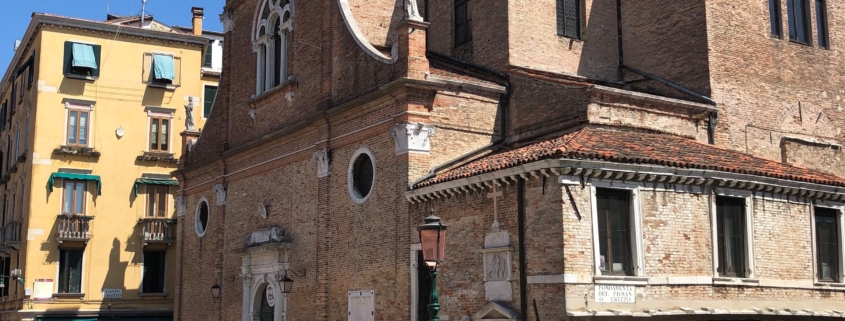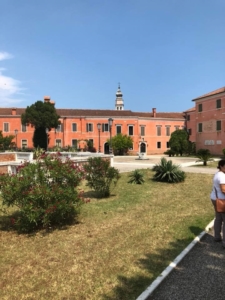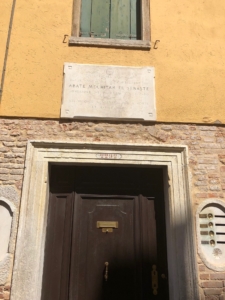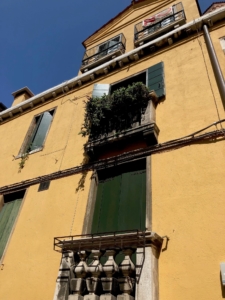A Rented House in Castello
July 6, 2018
Last week, my spouse Houri and I found the rented house in the Castello district where Abbot Mkhitar stayed for two years from the time following his arrival in Venice in April of 1715 to the day he and his ten or twelve disciples resettled on San Lazzaro on September 8, 1717. I had always known about this house being in Castello but had never bothered to seek it out, so it was a pleasant discovery of sorts for me to see the place with my own eyes and the plaque placed there to mark its memory. It turns out the the house is a stone’s throw from the apartment I have rented for my stay here. A day after I took the photos of the house, I looked at the Chronicle of Matteos of Evdokia (Mkhitar’s most trusted follower, who wrote the official chronicle of the congregation, and found the relevant passage concerning Mkhitar’s arrival (from Medon) at Alberoni (on the Lido) and his time at the quarantine in Venice. Following the customary forty-day stay there, Mkhitar and his disciples moved into a three-storied house in the parish of San Martino right next to the church there where Mkhitar said mass on Sundays. Below is a fairly literal and off-the cuff translation of the classical Armenian passage followed by the original transcription for those few who find pleasure or interest in such things:
“At the start of April, having lived through all manner of dangers through the care of our savior, we left the ship and in accordance to the security laws of the city we entered entered the Lazzareto or quarantine and rested there. After a few days, we began to say mass at a chapel inside the Lazzareto. And some among our acquaintances (both secular and religious) who were in Venice, would come to greet us and tell us about the conditions of life in the city, and show us how people lived there. Among them especially was an intimate friend of ours, a man by the name of Gevork who was from our nation. As a son of the congregation, he and his children would look after many of our needs from that point onward and always, going here and there and showing us the way. He would at once show us the morays and ways, the life and the customs on the city, the necessities to buy and how much to pay for them. And with such help and for the love of God, he was hospitable to us. At that time, Khatchatur Vardapet of Karin [Erzerum], about whom we have narrated here and there, was in Venice and was appointed by the Holy See as a missionary for the Armenians who were in the city and chaplain of their church. When our days at the Lazzareto were nearing completion, our Abbot spoke with Gevork about renting a suitable house for us. And upon the completion of our stay in quarantine, we went and took up residence at the house rented for us in Venice. This was on the twelfth day of the month of May in the year seventeen hundred and fifteen. And that house was attached to the church of San Martino, with two upper stories and was quite suitable and appropriate for our residence there. For on the uppermost floor, there were four spacious rooms, the middle floor had three rooms and a kitchen, and the lowest floor which was below the middle floor had three large storage storage areas and a well. As such the whole place was useful for us and had pious neighbors. The rent which we paid on a yearly basis was seventy-two piasters.
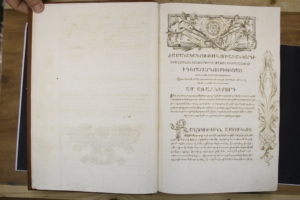 Ի սկզբան ապրիլի ամսոյն յամենայն վտանգից խնամօք փրկչին մերոյ ապրեալ, ելաք ՚ի նաւէ անտի. եւ ըստ օրինաց քաղաքին զգուշութեան ՚ի քառասնօրական նազարէթն մտեալ հանգեաք։ եւ յետ աւուրց ինչ սկիզբն արարաք անդէն ՚ի մատրան նազարէթին զպատարագս մատուցանել։ Եւ որք ՚ի ծանօթից մերոյ յաշխարհականաց, եւ յեկեղեցականաց ՚ի Վեհեշ գտան. գային յողջոյն մեզ. եւ զհանգամանս յերկրին բնակելոյ, եւ զկերպն վարելոյ ՝ ցուցանէին մեզ։ Յորս մանաւանդ անձուկ ընտանի բարեկամ մեր էր գէորգ անուն ոմն յազգէս յայոց. որ ՚ի բազում կարեւոր պէտս մեր իբրեւ որդի միաբանութեան մերում յայնմ հետէ եւ առ յապայ որդւովքն իւրովք հանդերձ աշխատ լինէր՝ այսր եւ անդր երթալով եւ մեզ ճանապարհս ցուցանելով։ Միանգամայն եւ զկացս, եւ զգնացս, զվարս եւ զսովորութիւնս քաղաքին. զգնելն- եւ զգինս իրաց պիտոյից ցուցանէր մեզ։ եւ այսպիսի նպաստութեամբ վասն սիրոյ տեարն ՝ ասպնջական լինէր մեզ։ Ընդ այն ժամանակս եւ կարնեցի խաչատուր վարդապէտն, զորոյ զզիարդն ՚ի վեր անդր ՚ի տեղիս տեղիս պատմեալեմք. ՚ի վեհեշ լինէր. եւ էր առաքեալ կարգեալ ՚ի սրբազան աթոռոյն ՚ի վերայ հայոցն, որք ՚ի վեհեշ լինին. եւ մատրանակալ եկեղեցւոյն նոցա։ Այն ինչ աւուրք նազարեթին ՚ի լրումն մերձենային. խօսեցաւ Աբբայահայրն մեր ընդ գէորգին զպատշաճաւոր տուն վարձել մեզ։ Եւ ՚ լրանալ աւուրցն գնացեալ բնակեցաք ՚ի վարձեալ տան մերում ՚ի վեհեշ՝յերկուտասաներորդում աւուր ամսեանն մայիսի՝յամին հազարերորդի եօթնհարիւրերորդի հնգետասաներորդի։ եւ տունն այն որմնակից էր եկեղեցւոյ սրբոյն մարտինոսի։ Երկպատեալ վերնայարկօք, պատճշաճաւոր ձեւով բնակութեան մերում կարի յարմարեալ։ Զի ՚ի վերնայարկի նորա էին չորս սենեակք ընդարձակք. եւ ՚ի միջնայարկին երեք սենեակք, եւ խօհակերոց մի։ Իսկ ՚ի ստորին մասին որ էր ՚ի ներքոյ միջնայարկին, էին յարկք երեք. եւ ջրհոր մի։ Եւ այնպէս բովանդակ մասամբք պիտանի էր. եւ դրացիքն բարեպաշտք էին։ Իսկ վարձքը, զոր ամ յամէ հատուցանէաք, էր եօթանասուն եւ երկու դահեկան։ (folio 192)
Ի սկզբան ապրիլի ամսոյն յամենայն վտանգից խնամօք փրկչին մերոյ ապրեալ, ելաք ՚ի նաւէ անտի. եւ ըստ օրինաց քաղաքին զգուշութեան ՚ի քառասնօրական նազարէթն մտեալ հանգեաք։ եւ յետ աւուրց ինչ սկիզբն արարաք անդէն ՚ի մատրան նազարէթին զպատարագս մատուցանել։ Եւ որք ՚ի ծանօթից մերոյ յաշխարհականաց, եւ յեկեղեցականաց ՚ի Վեհեշ գտան. գային յողջոյն մեզ. եւ զհանգամանս յերկրին բնակելոյ, եւ զկերպն վարելոյ ՝ ցուցանէին մեզ։ Յորս մանաւանդ անձուկ ընտանի բարեկամ մեր էր գէորգ անուն ոմն յազգէս յայոց. որ ՚ի բազում կարեւոր պէտս մեր իբրեւ որդի միաբանութեան մերում յայնմ հետէ եւ առ յապայ որդւովքն իւրովք հանդերձ աշխատ լինէր՝ այսր եւ անդր երթալով եւ մեզ ճանապարհս ցուցանելով։ Միանգամայն եւ զկացս, եւ զգնացս, զվարս եւ զսովորութիւնս քաղաքին. զգնելն- եւ զգինս իրաց պիտոյից ցուցանէր մեզ։ եւ այսպիսի նպաստութեամբ վասն սիրոյ տեարն ՝ ասպնջական լինէր մեզ։ Ընդ այն ժամանակս եւ կարնեցի խաչատուր վարդապէտն, զորոյ զզիարդն ՚ի վեր անդր ՚ի տեղիս տեղիս պատմեալեմք. ՚ի վեհեշ լինէր. եւ էր առաքեալ կարգեալ ՚ի սրբազան աթոռոյն ՚ի վերայ հայոցն, որք ՚ի վեհեշ լինին. եւ մատրանակալ եկեղեցւոյն նոցա։ Այն ինչ աւուրք նազարեթին ՚ի լրումն մերձենային. խօսեցաւ Աբբայահայրն մեր ընդ գէորգին զպատշաճաւոր տուն վարձել մեզ։ Եւ ՚ լրանալ աւուրցն գնացեալ բնակեցաք ՚ի վարձեալ տան մերում ՚ի վեհեշ՝յերկուտասաներորդում աւուր ամսեանն մայիսի՝յամին հազարերորդի եօթնհարիւրերորդի հնգետասաներորդի։ եւ տունն այն որմնակից էր եկեղեցւոյ սրբոյն մարտինոսի։ Երկպատեալ վերնայարկօք, պատճշաճաւոր ձեւով բնակութեան մերում կարի յարմարեալ։ Զի ՚ի վերնայարկի նորա էին չորս սենեակք ընդարձակք. եւ ՚ի միջնայարկին երեք սենեակք, եւ խօհակերոց մի։ Իսկ ՚ի ստորին մասին որ էր ՚ի ներքոյ միջնայարկին, էին յարկք երեք. եւ ջրհոր մի։ Եւ այնպէս բովանդակ մասամբք պիտանի էր. եւ դրացիքն բարեպաշտք էին։ Իսկ վարձքը, զոր ամ յամէ հատուցանէաք, էր եօթանասուն եւ երկու դահեկան։ (folio 192)
July 21, 2018
I had a very rare opportunity this evening of being invited, through my friend Minas, to view the interior of the historic house rented by Mkhitar Abbot between May of 1715 and September of 1717 right next to the church of San Martino in the Castello district of Venice about 6 minutes walk from my own apartment this summer. Minas’s friends, Marco Gagliardi and Piero-Andrea, whose father was a famous son of Venice and the region’s elected representative to Italy’s parliament and active in the Christian Democratic party, made my visit there possible. The father Vicenzo passed away in 1968 but his ailing wife still lives in the house the family has owned for generations or at least from the early nineteenth century. I will never forget the visit and took plenty of photos to document it and possibly for use in one of my next books. The house has four floors and is practically attached to the church of San Martino where Mkhitar used to perform mass on Sundays (see my post from two weeks ago if interested). The two units on the bottom floor were rented to tenants, but the Gagliardi family still lives on floors two, three, and four, where Mkhitar resided with his ten or so disciples before he was gifted the island of San Lazzaro on September 6, 1717. The house next to San Martino had all the requisite atmosphere and sense of smell one would expect of a historic place. It was as if the musty scent at the entrance with its old wooden gate and rickety staircase were there to transport me directly to the early eighteenth century. It might have been my active imagination of being in the presence of the clearly historic that was playing tricks on me. Or maybe it was the more prosaic possibility that the entrance smelled like someone had just burned frankincense. In any case, the owners are fully aware of the truly historic nature of their house. Mkhitar is a known personality in Venice and especially in Castello. The well (ջրհօր) described in the chronicle of the island as being on the ground floor is no longer there but Marco seemed to know of its presence in the past. He even showed us a hidden staircase from the second floor that used to once lead straight to the altar area of the church next door.
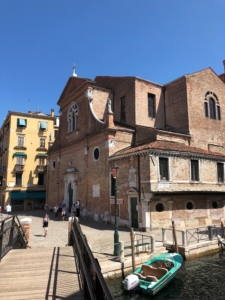 After this visit, I took leave of my two kind hosts and walked home. Since it was raining rather heavily, I had to make a dash inside an Osteria that I have passed by without ever wanting to find out what kind of establishment it was. “Osteria do Pozzi” on the Corte bearing the same name turned our to be one of the most authentic and more affordable holes-in-the wall that I’ve been to in Venice. The place is very unassuming and rustic or baroque in appearance. Only one table of German tourists and the food was modest (not the stuff of Anthony Bourdain’s shows) but definitely worth having, especially when the service is friendly and it’s pouring cats and dogs outside. Even more interesting, I had a rare moment of canine bonding with the cutest dog with an American flag/bandana wrapped around its neck as a collar. It walked into our joint out of nowhere and came straight to my table and wouldn’t move from my side for ten or fifteen minutes until its owners showed up. Anyway, all in all, I had a most rewarding Saturday and can now say that thanks to the Gagliardi family and Minas, I have seen and experienced in an olfactory way the history I am writing about through silent documents.
After this visit, I took leave of my two kind hosts and walked home. Since it was raining rather heavily, I had to make a dash inside an Osteria that I have passed by without ever wanting to find out what kind of establishment it was. “Osteria do Pozzi” on the Corte bearing the same name turned our to be one of the most authentic and more affordable holes-in-the wall that I’ve been to in Venice. The place is very unassuming and rustic or baroque in appearance. Only one table of German tourists and the food was modest (not the stuff of Anthony Bourdain’s shows) but definitely worth having, especially when the service is friendly and it’s pouring cats and dogs outside. Even more interesting, I had a rare moment of canine bonding with the cutest dog with an American flag/bandana wrapped around its neck as a collar. It walked into our joint out of nowhere and came straight to my table and wouldn’t move from my side for ten or fifteen minutes until its owners showed up. Anyway, all in all, I had a most rewarding Saturday and can now say that thanks to the Gagliardi family and Minas, I have seen and experienced in an olfactory way the history I am writing about through silent documents.


